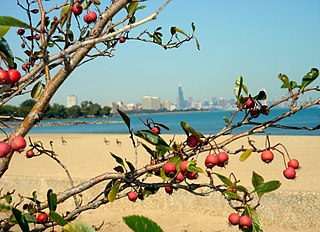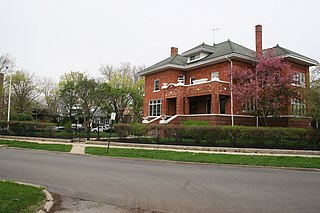
South Shore is one of 77 defined community areas of Chicago, Illinois, United States. Located on the city's South Side, the area is named for its location along the city's southern lakefront. Although South Shore has seen a greater than 40% decrease in residents since Chicago's population peaked in the 1950s, the area remains one of the most densely populated neighborhoods on the South Side. The community benefits from its location along the waterfront, its accessibility to Lake Shore Drive, and its proximity to major institutions and attractions such as the University of Chicago, the Museum of Science and Industry, and Jackson Park.

Hermosa is one of 77 designated Chicago community areas and is located on the northwest side of Chicago, Illinois. The Hermosa community area contains the Kelvyn Park and Hermosa neighborhoods. The area includes the birthplace of Walt Disney and is the former headquarters of the Schwinn Bicycle Company. While being one of the smaller community areas, Hermosa is one of the city's most densely populated neighborhoods.

West Ridge is one of 77 Chicago community areas. It is a middle-class neighborhood located on the far North Side of the City of Chicago. It is located in the 50th ward and the 40th ward.

Chatham is one of the 77 community areas of Chicago, Illinois, on the city's South Side. It includes the neighborhoods of Chatham-Avalon, Chatham Club, Chesterfield, East Chatham, West Chatham and the northern portion of West Chesterfield. Its residents are predominantly African American, and it is home to former Senator Roland Burris. Housing many city employees and other officials, Chatham has been a central area for Chicago's middle-class African Americans since the late 1950s.

Washington Heights is the 73rd of Chicago's 77 community areas. Located 12 miles (19 km) from the Loop, it is on the city's far south side. Washington Heights is considered part of the Blue Island Ridge, along with the nearby community areas of Beverly, Morgan Park and Mount Greenwood, and the village of Blue Island. It contains a neighborhood also known as Washington Heights, as well as the neighborhoods of Brainerd and Fernwood. As of 2017, Washington Heights had 27,453 inhabitants.

The boundary markers of the original District of Columbia are the 40 milestones that marked the four lines forming the boundaries between the states of Maryland and Virginia and the square of 100 square miles (259 km2) of federal territory that became the District of Columbia in 1801. Working under the supervision of three commissioners that President George Washington had appointed in 1790 in accordance with the federal Residence Act, a surveying team led by Major Andrew Ellicott placed these markers in 1791 and 1792. Among Ellicott's assistants were his brothers Joseph and Benjamin Ellicott, Isaac Roberdeau, George Fenwick, Isaac Briggs and an African American astronomer, Benjamin Banneker.

The Villa District, also known as Villa Historic District, is a historic district in Chicago, Illinois, United States. It is located on Chicago's Northwest Side within the community area of Irving Park. Its borders are along Pulaski Road to the west, the Union Pacific/Northwest rail line to the north, Hamlin Avenue to the east, and Addison Street to the south. Located directly north of the Wacławowo area of Avondale, the Villa District is serviced by the Blue Line's Addison street station.

Jefferson Park is a 7-acre (2.8 ha) park in the Jefferson Park community area of Chicago, Illinois on the National Register of Historic Places.

The Ravenswood Manor Historic District is a historic district in the Albany Park community area of North Side, Chicago, Illinois. It is bordered by the Chicago River on the East, and by the alley south of Lawrence Avenue on the North, Sacramento Avenue on the West, and the alley North of Montrose Avenue on the south.

The Oak Circle Historic District is a historic district in Wilmette, Illinois, United States. The district covers 2.6 acres (0.011 km2) and includes twenty-two contributing properties and four non-contributing properties, all located along Oak Circle. It primarily consists of fifteen single-family homes representative of the Prairie School and Craftsman styles of architecture. The Oak Circle Historic District was added to the National Register of Historic Places on June 21, 2001; it was the first historic district to be designated in Wilmette.

The Logan Square Boulevards Historic District is a linear historic district in the Logan Square community area of North Side, Chicago. It encompasses 2.5 miles (4.0 km) of the Chicago boulevard system.

The South Shore Bungalow Historic District is a residential historic district in the South Shore neighborhood of Chicago, Illinois. The district contains 229 Chicago bungalows and twenty other residential buildings built between 1911 and 1930. As homes became more accessible to families in early 20th century Chicago, thousands of bungalows were built to meet the housing demand. While bungalows were affordable mainly due to their uniform designs, their builders changed details such as color and entrance position to keep each home unique. The South Shore bungalows were among the first built in the city, as South Shore was already a popular neighborhood when the bungalow boom began, and the district contains many 1910s stucco bungalows; however, every bungalow built after 1917 is brick.

The West Chatham Bungalow Historic District is a residential historic district in the Chatham neighborhood of Chicago, Illinois. The district includes 283 Chicago bungalows built between 1913 and 1930 along with a smaller number of other residential buildings. As Chicago grew in the early 20th century and homeownership became more accessible, the bungalow arose as a popular and affordable house design, and tens of thousands of them were built in the city. Chatham, an outlying neighborhood on the city's South Side, benefited from this housing boom, as its transit connections made the area an attractive choice for new housing. The West Chatham bungalows are all brick and feature similar designs, giving the neighborhood a uniform appearance; however, decorative features such as patterned brickwork provide diversity among the homes.

The Schorsch Irving Park Gardens Historic District is a residential historic district in the Dunning neighborhood of Chicago, Illinois. The district includes 255 buildings, all but three of which are Chicago bungalows. In the early twentieth century, tens of thousands of Chicago bungalows were built in the city; as homeownership became more accessible to working-class Chicagoans, demand for housing increased, and bungalows were an affordable way of meeting this demand due to their relatively uniform design. The bungalows in the district were largely built either between 1917 and 1918 or between 1922 and 1926. Unlike Chicago's other bungalow-dominated neighborhoods, which often had several different developers, developer Albert J. Schorsch built every bungalow in the district, and architech Ernest N. Braucher designed all of them. To add diversity to a neighborhood made up of only one style of house, the two men varied the homes' roof shapes, colors, and dormers.

The Wrightwood Bungalow Historic District is a residential historic district encompassing the 4600 and 4700 blocks of Wrightwood Avenue in the Belmont Cragin neighborhood of Chicago, Illinois. The district includes 58 houses built between 1916 and 1926, 55 of which are Chicago bungalows. As homeownership became more accessible in early twentieth century Chicago, the bungalow became popular as an affordable home design, and tens of thousands of the houses were built throughout Chicago. Like many of Chicago's bungalow-heavy neighborhoods, both the district and the Belmont Cragin neighborhood in general saw little residential development before the bungalow boom; however, the area was much more industrial than most similar neighborhoods. While several developers built bungalows in the district, the Stolzner Construction Company built over half of them, including every bungalow on the 4600 block. The company's architect, Joseph Klafter, differentiated the bungalows by changing details such as their color, entrance position, and dormer design.

The Falconer Bungalow Historic District is a residential historic district in the Belmont Cragin neighborhood of Chicago, Illinois. The district comprises 348 Chicago bungalows built from 1915 to 1931. As homeownership became more affordable in early twentieth century Chicago, the bungalow became popular as an affordable and easily replicable home style, and tens of thousands of the homes were built throughout the city. While more industrial than average, the Belmont Cragin area was otherwise typical of the new bungalow neighborhoods, as it was an underdeveloped area on the outskirts of the city. Laughlin Falconer, for whom the district is named, owned and farmed on the land before dividing it and selling it to developers in 1913. Architects Ernest Braucher and Johan F. Knudson designed most of the bungalows in the district; both architects frequently gave their houses full-length, open-air front porches, and the district has one of the city's most significant collections of open front porch bungalows as a result.

The Talman West Ridge Bungalow Historic District is a residential historic district in the West Ridge neighborhood of Chicago, Illinois. 181 of the district's 272 buildings are either brick Chicago bungalows or older stucco bungalows built from 1919 to 1930. As homeownership became more affordable in early twentieth century Chicago, the bungalow became popular for its easily and cheaply replicated design, and tens of thousands of the homes were built throughout the city. West Ridge, a lightly developed area on Chicago's northern border, was typical of the neighborhoods that were dominated by new bungalows. While a variety of developers and architects built the district's bungalows in distinctive fashions, the homes' similar designs and consistent setbacks from the street give the district a cohesive appearance.

The Portage Park Bungalow Historic District is a residential historic district in the Portage Park neighborhood of Chicago, Illinois. The district includes 225 buildings, 189 of which are brick Chicago bungalows built between 1915 and 1930. As homeownership became broadly accessible to Chicagoans in the early twentieth century, the bungalow emerged as a popular and affordable house design, and tens of thousands of the homes were built throughout Chicago. Portage Park was one of the many outlying neighborhoods of Chicago which grew dramatically as a result of the housing boom; new residents were also attracted to the neighborhood's eponymous park. While the district was developed by many different builders and architects, the use of a single home type with uniform setbacks from the street gives the neighborhood a consistent appearance.
The Gage Park Bungalow Historic District is a residential historic district in the Gage Park neighborhood of Chicago, Illinois. The district includes 465 Chicago bungalows and eighteen other residential buildings. The bungalows were built between 1919 and 1931, a time in which single-family homeownership became broadly accessible in Chicago; as bungalows could be mass-built affordably, they appealed to these new homeowners. Gage Park, an underbuilt neighborhood in southwest Chicago, was one of the many outlying areas of the city in which large numbers of new bungalows were built in the early twentieth century. While the bungalows have a consistent shape and are set back evenly from the street, giving the district a uniform appearance, variations in color, brick patterns, and roof forms differentiate the individual houses.

The Herbert A. Dilg House is a historic house at 8544 Callie Avenue in Morton Grove, Illinois. The house was built circa 1925-26 by owner and Morton Grove mayor Herbert A. Dilg. The grandson of an early Morton Grove settler, Dilg served as the village's mayor from 1925 to 1926 and again from 1931 to 1944, overseeing its transition into a suburban community of Chicago. Dilg designed his house in the Chicago bungalow style, a popular choice for middle-class homes in early twentieth century Chicago. The brick house's design includes an octagonal bay containing the living room, a raised front porch at the main entrance, a dormer, and a clay tile roof. Unlike many of the bungalows in the Chicago area, the house is part of a diverse group of houses rather than a row of similar bungalows.





















